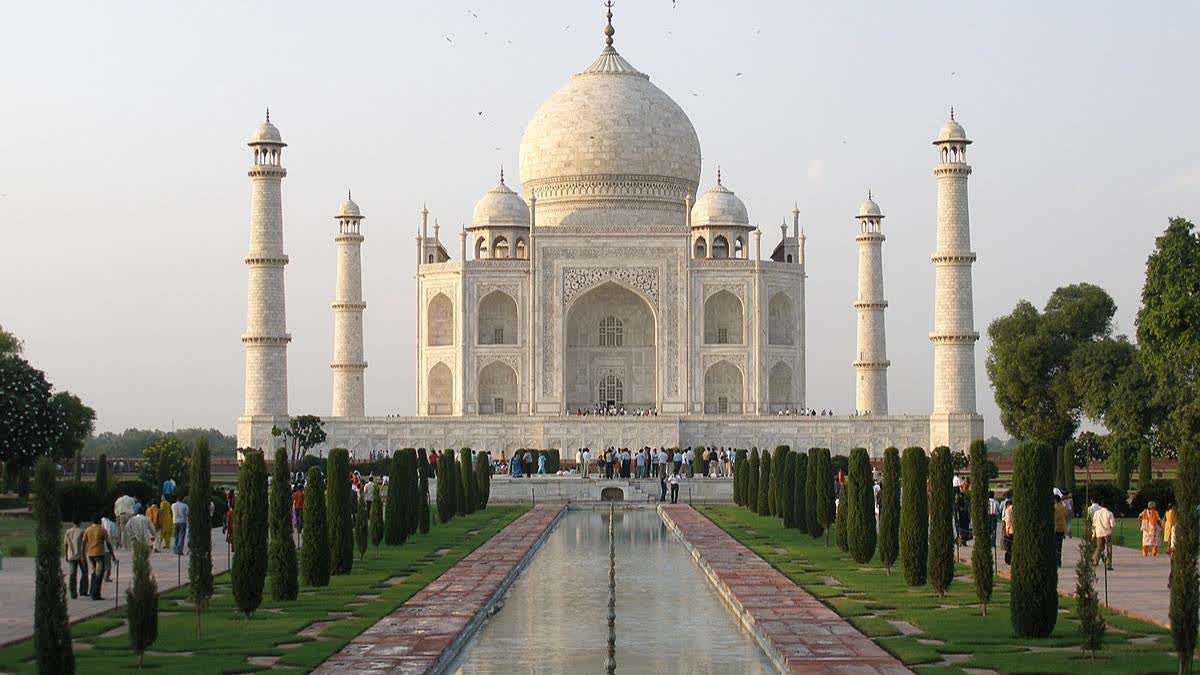Agra (Uttar Pradesh): A team of scientists from the Archaeological Survey of India (ASI) surveyed the rain-induced damage to the Taj Mahal with the help of drones. The preliminary investigation report revealed that water dripped from the urn due to rust in the iron angle used as support for the brass urn on the top of the main dome. The 30.5-foot urn, from which water dripped, was made of 466 kg gold and was replaced thrice in 377 years and the last one is made of brass.
The Taj, one of the eight wonders of the world, was completed in 16 years from 1632 to 1648 on the banks of Yamuna under the instruction of Mughal emperor Shahjahan in memory of his beloved wife Mumtaz. Along with white marble, precious stones procured from abroad also were used in the construction. More than 20,000 masons worked day and night to build the eternal beauty. In 1983, it was accorded the World Heritage Site tag by UNESCO.
Senior archaeologist Rajkishore ‘Raje’ of Agra said Mumtaz died on June 17, 1631, in Burhanpur while giving birth to her 14th child Gauhara Begum. She was buried on the banks of the Tapi River in Burhanpur. Shahjahan was dejected by her death and he built the Taj Mahal to make her immortal. Her body was brought to Agra, 790 kilometres away from Burhanpur to be ensconced in the Taj.
Rajkishore said Shahjahan spent a humongous amount on the construction of the Taj. Along with white marble, shiny and precious stones were brought from abroad for its embellishment. The artisans carved them and used inlay work on the edifice, which adds to the beauty of the Taj Mahal.
To make it shiny and sparkling, the emperor had a golden urn made with 466 kgs of gold from the royal treasury to be placed atop the Taj. Kazim Khan, the craftsman, was specially summoned from Lahore to make it shiny so that eleven the sunlight could sparkle on it.
‘Tarikh-e-Agra’ has a mention of the golden urn. In 1803, when the British took over the Agra Fort, the urn was removed by an officer, Joseph Taylor, in 1810 and installed a copper urn with gold polish. It was replaced in 1876 for the second time. In 1888 on the instruction of an archaeological officer, an artisan, Nathuram, made a shape of the urn according to the length and width of the jasmine floor in front of the guest house in the Taj Mahal complex to avoid any measurement mistakes in future. Again, the urn was changed in 1940 for the third time.
ASI’s superintending archaeologist Dr. Rajkumar Patel said an investigation has been conducted into the damage and leakage caused to all the monuments protected by the ASI. There is a possibility of water dripping into the main mausoleum through the brass urn installed atop as there could be rust in the iron joints used to install it. Rust causes metal to swell leading to cracks in the stone. Repair and maintenance work will be undertaken. The mausoleum and its premises are cleaned every Friday.
Samajwadi Party supremo and former Chief Minsiter Akhilesh Yadav raised questions on the maintenance of the Taj Mahal.
In an X post, he said, “The BJP government and its dormant departments have completely failed in the maintenance of the Taj Mahal, the wonder that attracts tourists from all over the world. There is a possibility of rust in the metal of the urn on the main dome. Water is dripping from the main dome. The news of trees growing in the dome is in the headlines. If the roots of such trees grow, then cracks can appear in the Taj Mahal. The Taj Mahal complex has become a sanctuary for monkeys. There is a problem of waterlogging in the Taj Mahal complex. The problem for tourists is whether they should admire the Taj Mahal or deal with the problems. All these reasons tarnish the country's image globally among tourists coming from all over the world. The question is, where does the crores of rupees of funds that come for the maintenance of the Taj Mahal go? Government should be a living and active example, not just a monument”.
Read More:



